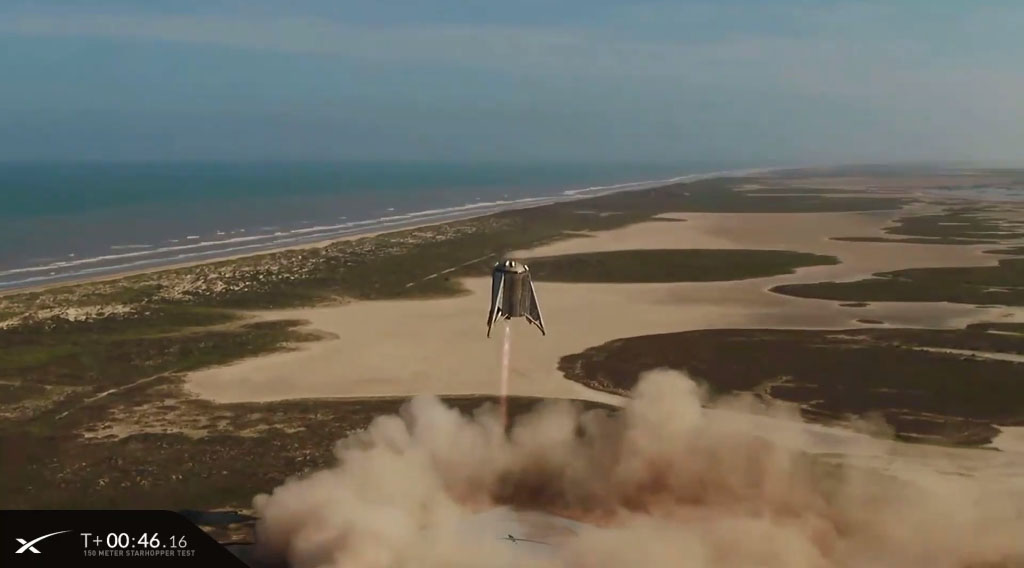SpaceX's Next Starship Prototype Launch Will Be a 12-Mile-High Test Flight, Elon Musk Says

If you thought SpaceX's Starhopper test flight this week was amazing, just you wait.
That's the message from SpaceX founder and CEO Elon Musk on the heels of his company's successful Starhopper launch on Tuesday (Aug. 27). In a Twitter post on Wednesday (Aug. 28), Musk said SpaceX's next Starship prototype will launch to a height of 12 miles (20 kilometers) in just over a month, with an orbital launch to follow "shortly thereafter." Starhopper aimed for a 500-foot (150 meters) ceiling on the recent test.
"Aiming for 20km flight in Oct & orbit attempt shortly thereafter," Musk said on Twitter before making another promise to his followers. "Starship update will be on Sept. 28th, anniversary of SpaceX reaching orbit. Starship Mk 1 will be fully assembled by that time."
Video: Watch SpaceX's Starhopper Launch on Epic Flight
That Starship update is expected to be Musk's annual presentation on tweaks and changes to the massive reusable launch system's design from the last year. Musk has held a presentation each year since 2016, when he first unveiled the ambitious space transportation system at the International Astronautical Union meeting in Mexico City.
Initially, Musk dubbed the fully reusable heavy lift launch system the Interplanetary Transport System, or ITS, for Mars colonization. A year later, at the IAU meeting in Adelaide, Australia, Musk presented an updated design and new name: The Big Falcon Rocket, or BFR.
Aiming for 20km flight in Oct & orbit attempt shortly thereafter. Starship update will be on Sept 28th, anniversary of SpaceX reaching orbit. Starship Mk 1 will be fully assembled by that time.August 28, 2019
Then in September 2018, Musk dropped a bombshell. At SpaceX's rocket factory in Hawthorne, California, he unveiled that the company had signed Japanese billionaire Yusaku Maezawa as the first customer for a Starship flight around the moon in 2023. Musk also presented yet another updated design for the launch system (still called BFR). The name Starship (and Super Heavy for its first-stage booster) were rolled out later.
Breaking space news, the latest updates on rocket launches, skywatching events and more!
SpaceX's current plans for Starship call for a 100-passenger spacecraft powered by six of the company's Raptor rocket engines. Starhopper, for comparison, used a single Raptor engine, while the Mark 1 Starship will apparently use three Raptors for early tests. When Starship and the Super Heavy are on the launchpad, they'll stand 387 feet (118 meters) tall, Musk has said.
Those details may change on Sept. 28, when Musk rolls out his Starship and Super Heavy update. He has said the presentation will he held at SpaceX's Boca Chica test site in South Texas, home of the Starhopper and the first Starship prototype, the Mark 1. (A second, the Mark 2, is being built at SpaceX's facility in near Cape Canaveral, Florida.)
- Elon Musk: Revolutionary Private Space Entrepreneur
- See the Evolution of SpaceX's Rockets in Pictures
- SpaceX: First Private Flights to Space Station
Email Tariq Malik at tmalik@space.com or follow him @tariqjmalik. Follow us on Twitter @Spacedotcom and on Facebook.

Tariq is the award-winning Editor-in-Chief of Space.com and joined the team in 2001. He covers human spaceflight, as well as skywatching and entertainment. He became Space.com's Editor-in-Chief in 2019. Before joining Space.com, Tariq was a staff reporter for The Los Angeles Times covering education and city beats in La Habra, Fullerton and Huntington Beach. He's a recipient of the 2022 Harry Kolcum Award for excellence in space reporting and the 2025 Space Pioneer Award from the National Space Society. He is an Eagle Scout and Space Camp alum with journalism degrees from the USC and NYU. You can find Tariq at Space.com and as the co-host to the This Week In Space podcast on the TWiT network. To see his latest project, you can follow Tariq on Twitter @tariqjmalik.
